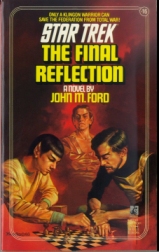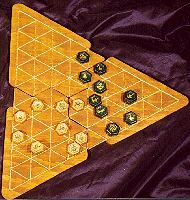Klin Zha
Klin Zha is a Klingon board game, similar in concept to Earth Chess. It has been made known to humans by a Star Trek novel, "The Final Reflection", written by John M. Ford.
Just as Chess developed into something more than just an aristocratic pastime due to the many levels of social/political significance that it acquired in the Middle Ages, so did Klin Zha. But Chess is Human. During its history, Humanity endowed Chess with tactics first, then strategy. On then, to spirituality, religion and, finally, to the mathematically intellectual exercise that it is currently played by the grand masters.
Klin Zha, however, is Klingon. It teaches you to think like a Klingon. It is not limited to the upper classes. Even the youths in lineless houses revere and play the game. It remains tactical, calculating . . . and yet filled with the spirit and morés of the people from which it evolved. If not, it would not have continued in honor in Klingon culture which esteems only triumph and victory resulting from personal courage, honor and initiative.
It is traditional for a Chess player to announce his victory by stating the obvious: "Checkmate." The Klin Zha winner says, "Zha riest'n, teskas tal tai-kleon." Translation: "A Pleasant game. My compliments to a worthy opponent."
Object of the game.
The object of Klin Zha is to capture your opponent's goal or make it impossible for your opponent to move legally.
Description of the board and pieces.
The board is triangular, marked with a triangular grid of nine triangles per side, giving a total of eighty-one playing spaces.
There is an additional division of the board which is not visible, but is merely understood. That is the division of the playing area into three corners, or points. Each player arranges his or her pieces within one of the board's points. Action extends out over the full board as play proceeds.
The half-spaces of each point are not available for piece placement, representing a sort of no-man's-land between opposing sides.
Playing pieces may be carved or formed from materials into recognizable shapes or simple disks marked with the symbols of the pieces. There are nine pieces and one Goal per side; the traditional colors for each side being green and gold. A complete set would have twenty-seven pieces and three goals: nine green, nine gold and nine of combined colors for the Reflective Game with three Goals of corresponding color.The pieces include 1 Fencer, 1 Lancer, 1 Swift, 2 Fliers, 3 Vanguards, 1 Blockader and the Goal, the very important non-piece. The symbols of the pieces are not given in "The Final Reflection." They could be Klingon letters or images like military unit identification brass that signify the duties, power or characteristics of the individual pieces.
Origins and characteristics of the pieces.
As in the game of Chess, the gaming pieces for Klin Zha no doubt originated from the maneuvering capabilities of soldiers on the field of battle. The names of the individual pieces and some hints from the literature of author John Ford helped to formulate the following movement structure. Some constrictions were also imposed by the triangular format of the playing field with its eighty-one spaces.
The Fencer is the team or squad leader. The Vanguards, like pawns, are the weakest. The Swift strikes rapidly. The Flyers can jump over other pieces but cannot carry the Goal. The Blockader cannot carry the Goal except in klin zha kinta. The Goal can be abandoned on a space, it can be carried along when its present "carrier" piece moves, or it can be transferred to another piece that has just moved.
The Fencer (1). The symbolic leader and, therefore, by definition, always the strongest piece on the field. Moves 1, 2 or 3 unobstructed spaces in any direction and combination.
The Lancer (1). A mounted warrior for heavier shock attack. Moves 1, 2 or 3 unobstructed spaces straight in any direction.
The Swift (1). Moves rapidly to the attack. Light infantry. Commandos. A hero-type for quick-strike harrying actions. It cannot carry the Goal. Moves 2, 3 or 4 unobstructed spaces in any direction or combination.
The Fliers (2). Warriors equipped with anti-gravitation packs for longer range forays on the battlefield. Can jump over other pieces. It cannot carry the Goal. Move 3, 4, 5 or 6 spaces straight in any direction. Can jump over other pieces including those protected by the Blockader.
The Vanguards (3). The forward patrol. Advance field troops. Stodgy, foot-slogging front line infantry. Move 1 unobstructed space in any direction.
The Blockader (1). A warrior carrying a field portable (though heavy and cumbersome) force-field generator of limited range, to protect areas of the battlefield from missiles or ground assault troops. The Blockader's unique power makes it necessary that it be prohibited from carrying the Goal, or it would be immune to capture; or from executing a kill, as the Blockader itself is invulnerable. Moves 1 or 2 unobstructed spaces in any direction. Cannot carry the goal, kill another piece or be killed. Opposing pieces cannot enter any adjoining space nor can the Blockader move into a space occupied by or adjoining an opposing piece. Opposing Blockader zones of control cannot overlap.
The Goal (1). The game's important "non-piece." It does not represent a soldier. Technically, it is not a piece at all. It stands for the Klingon's personal goal: the spirit and ideal of military cunning and accomplishment -- the klin itself. The goal is represented by a small disk that cannot move by itself. It can be carried about by a warrior or even abandoned on a space by a piece that moves away, but it cannot be endangered intentionally. It is to be captured by an opponent. When left unattended on a space, the Goal does not pose an obstruction to the movement of the warrior pieces.
The Goal cannot be carried by the far-ranging attack soldiers, the Swift or Flyers, as it should rightly stay within the heart of the army. Neither can it be carried within the protection of the Blockader. Again, that would make it impossible to capture from a gaming standpoint. The goal can be moved with a Carrier piece through the blockader's zone-of-control on its way to its destination.
Remember, this is a Klingon game. You must expose and flaunt your spirit of combat and valor; not hide it without honor. True Klingon courage and militarism must constantly present an open challenge to an opponent.
The Spindles
Spindles are used to begin the game. They are two hexagonal rods, white with gold lettering and numbered on the sides, 1 through 6. For play here, of course, standard six-sided cubic dice may be substituted.
The Manner of Play (Open Game).
The spindles are thrown to decide first and second placement. The winner of the throw may grant the option to "choose first position" to his opponent or not. To set up first reveals your thoughts and is a disadvantage.
First one side sets up his or her entire set of pieces in any arrangement within one of the "points" of the board. Then the other player does the same within one of the two remaining points, leaving the third point open. The action of the game will expand out out into the third corner as the game progresses. After both sides have placed their pieces, the Goals are placed with "carrier" pieces.
The color with the first placement moves first.
Pieces move on the triangles, side-to-side, rather than point-to-point.
Opponent's pieces are removed from play by landing on the space that they occupy ad the end of the attacker's movement. In Human Chess, this is called a "capture." In Klin Zha, the piece is "killed."
It is illegal to make any move that endangers your own Goal.
Notation
The basis for playing Klin Zha by mail, e-mail, phone or otherwise without having a visual representation of the board is to have a coordinate mapping system. Chess has it easy with square spaces and an X-Y mapping system, traditionally adding location names based on the starting positions of the pieces. Klin Zha's equilateral triangles and free-form starting positions make that a little more difficult.

With the board situated with a point at the top and expanding towards the bottom, designate rows as A through I along the vertical edges. Designate the nine triangles across the bottom as 1 through 9. (Actually, any two sides lettered with the third side numbered will yield proper coordinates.)
Each space can be uniquely defined by its lettered horizontal "row" and the two numbered "columns" that run parallel with the two vertical sides. The corners would be designated A-19, I-11 and I-99 (or I-90). The example illustration shows E-38.
As a convention, the name of the piece, the space it's moving from and the space it's moving to would be stated in addition to a comment if it is moving the goal or leaving it behind. For example: Fencer with Goal at H-78 to G-57.
Forms of the game
Variations to the board or rules provide five forms of Klin Zha: Clouded, Blind, Ablative, Open (the standard game) and Reflective. See the Klin Zha Homepage for details.
Links
To know about strategies and tactics, about the numerous Klin Zha variants, to read and check an interesting FAQ, to admire wonderful Klin Zha sets and boards, please go to :
- The Klin Zha Homepage. (Link.)
- The Klingon Langage Institute a fascinating site to learn to speak like aliens.
Zillions-of-Games files
L. Lynn Smith made a very nice zrf file to play Klin Zha. Download it here.
Also, he programmed a fascinating 3D variant of Klin Zha which is worth to see. Download it here.
Written by Jean-Louis Cazaux. Most parts of the text were taken from the Klin Zha Homepage maintained by Kevin A. Geiselman.
Korath sutai-Ang'K'Tolax with Kordite sutai-Tasighor
Rules for the game Klin Zha Copyright © 1989 by Leonard B. Loyd, Jr.
.
WWW page created: November 18, 2001. Modified November 24, 2001.



